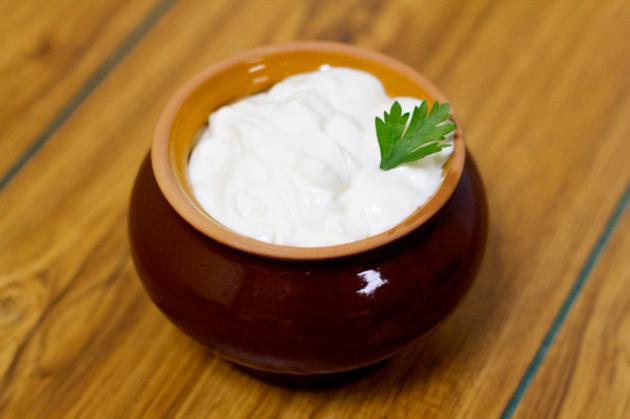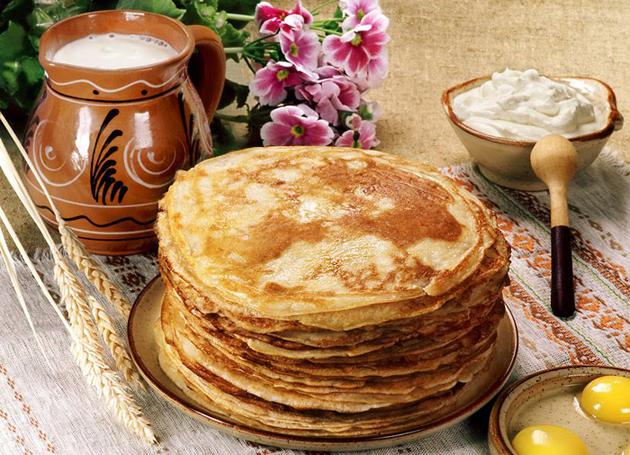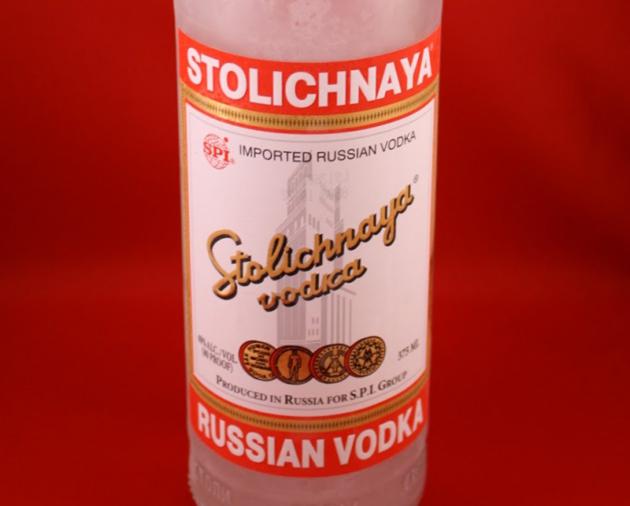620
Feast
The conventional stereotype goes: Russian cuisine to taste only Russian. Take menu overseas Russian restaurants - it is as dull as weekdays Brighton Beach And our contribution to the international trade in food products? He allegedly exhausted sorokogradusnoy. All this is not true! While our traditional Russian food manufacturers complain how difficult it is to deduce the Russian brands on the world market, foreign companies have successfully mastered their independent release. At the same time something that is already being produced on a large scale and gradually ceases to be an exotic
6 products via slon
Kefir
It would seem, for the Europeans, who are used to a sweet yogurt taste kislomolochki be unusual, but makes itself felt passion for a healthy diet. And if in some countries can be met most analogues of yogurt and sour milk under common names, in others it is already beginning to allocate products with traditional Russian recipe. For example, 3% Kefir, packaging which decorate the dome of the Cathedral of St. Basil, produces one of the largest producers of dairy products in the world, the Danish concern Arla Foods. Production volumes were not disclosed, but it is hardly a company with an annual turnover of nearly 8, 5 billion euros would deal with small things, aimed only at immigrants. There are in Europe and many other, albeit smaller, manufactures a la Russian kislomolochki, for example, many stores sold yogurt Germany Kalinka from companies Muler

Smetana
What abroad not buy sour cream - nothing more than a stereotype. Products, at least very much resembling it, usually called simply another (Crème etc.), and their diversity may be even greater than in Russian stores. Not to mention the countries of Eastern Europe, where the cream - a traditional product, as well as in Russia. At the same time, many foreign manufacturers produce exactly Russian Smetana, implying her "cream", usually with a higher fat content (47%), which is used in traditional Russian dishes like borscht, dumplings and pancakes. Although gradually moving away from this stereotype, and it can be found for the European traditional cream "cream" 23% fat. For example, Smetana produced by several manufacturers in Finland - a joint venture between Arla already mentioned and Ingman and Valio. By the way, the first, according to the manufacturer, is available for the past 65 years.

Russian Salad
Yes, Olivier (aka "Capital" or "Meat") was invented by a French chef, but hardly anyone would argue with the fact that this Russian national dish. And while a Russian restaurant, he displaced a dietary "Caesar" and "Greek" in foreign - on the contrary, is gaining in popularity, wearing the proud name of Russian Salad or Moscow Salad. Estimate the number of Russian salad, eaten abroad is not possible, but if you take, for example, Spain, where it is particularly popular there, Ensalada rusa included in the menu of one of the largest restaurant chains Lazarran (more than 200 outlets in Spain, plus overseas offices) and at one time was a member of the local board menu airline Vueling. However, the recipe is still corrected by Mediterranean flavors - somewhere you can meet Russian salad with tuna, but somewhere - even with olives. In some European countries under the name of Russian Salad Olivier was not meant, but the classic vinaigrette

Pelmeni
Ravioli - a true symbol of Russian specialties such as meatballs or burgers for the Swedes for the Americans. Many Russian manufacturers (for example, "Darya") even tried to export, but do it with frozen semi-finished products is not easy. All the more so abroad dumplings also produce on an industrial scale - at one time the Estonian manufacturer Uvic even begun to export them to Russia (than not export samovar to Tula?). Gradually dumplings beyond the boundaries of the former Soviet Union since, but with neighboring countries - if you pronounce the magic word Pelmeni in Finland, then you will understand without translation. Dish though is there is in the status of delicacy, but it is widely known and developed by local producers. Dumplings produces, in particular, a small family business Deliciest Oy, with an assortment of products from the beef, pork, venison and potatoes.

Blinis
It is clear that the pancakes - it is not only Russian food: Americans have pancakes, the French - crepes, etc. Meanwhile, it is believed that Russian pancakes still makes for a special recipe, which is allows you to allocate them in a separate category. In Germany, for example, is quite familiar with the word blinis, being understood by them several options - and the usual Russian pancakes, and pancakes with a stuffing, and pancakes. In the stores are rare, most pancakes are found in the menu of some restaurants and cafes.

Vodka
Vodka - as it is known, has long been an international product of the ten best-selling vodka brands in the world, only four produced in Russia, the first two places are occupied by the American Smirnoff and Swedish Absolut. Even sold in many foreign stores Stolichnaya, affectionately known there Stoli, for the most part of the Lithuanian bottling (the share of "Capital" Moscow plant "Crystal" in the world market considerably fewer). Vodka is produced not only the giants, specializing in international brands like Diageo and Pernod Ricard, and relatively small-scale producers. Here are a couple of amusing European attempts to emphasize the "Russian" flavor. For example, the French company Les Grands Chais De France has launched vodka Jelzin, which even refused to register in Russia, believing that the name misleads the consumer, - it is reasonable may find that vodka made in Russia. German producer Henkell & Co. (the largest producer of sparkling wines in Europe) produces vodka Gorbatschow, proudly calling it the most popular vodka in Berlin. And, according to legend, it has no relation to the Soviet leader, and got its name by the name of a family of emigrants who fled from the Russian Revolution.

Source: http: //
6 products via slon
Kefir
It would seem, for the Europeans, who are used to a sweet yogurt taste kislomolochki be unusual, but makes itself felt passion for a healthy diet. And if in some countries can be met most analogues of yogurt and sour milk under common names, in others it is already beginning to allocate products with traditional Russian recipe. For example, 3% Kefir, packaging which decorate the dome of the Cathedral of St. Basil, produces one of the largest producers of dairy products in the world, the Danish concern Arla Foods. Production volumes were not disclosed, but it is hardly a company with an annual turnover of nearly 8, 5 billion euros would deal with small things, aimed only at immigrants. There are in Europe and many other, albeit smaller, manufactures a la Russian kislomolochki, for example, many stores sold yogurt Germany Kalinka from companies Muler

Smetana
What abroad not buy sour cream - nothing more than a stereotype. Products, at least very much resembling it, usually called simply another (Crème etc.), and their diversity may be even greater than in Russian stores. Not to mention the countries of Eastern Europe, where the cream - a traditional product, as well as in Russia. At the same time, many foreign manufacturers produce exactly Russian Smetana, implying her "cream", usually with a higher fat content (47%), which is used in traditional Russian dishes like borscht, dumplings and pancakes. Although gradually moving away from this stereotype, and it can be found for the European traditional cream "cream" 23% fat. For example, Smetana produced by several manufacturers in Finland - a joint venture between Arla already mentioned and Ingman and Valio. By the way, the first, according to the manufacturer, is available for the past 65 years.

Russian Salad
Yes, Olivier (aka "Capital" or "Meat") was invented by a French chef, but hardly anyone would argue with the fact that this Russian national dish. And while a Russian restaurant, he displaced a dietary "Caesar" and "Greek" in foreign - on the contrary, is gaining in popularity, wearing the proud name of Russian Salad or Moscow Salad. Estimate the number of Russian salad, eaten abroad is not possible, but if you take, for example, Spain, where it is particularly popular there, Ensalada rusa included in the menu of one of the largest restaurant chains Lazarran (more than 200 outlets in Spain, plus overseas offices) and at one time was a member of the local board menu airline Vueling. However, the recipe is still corrected by Mediterranean flavors - somewhere you can meet Russian salad with tuna, but somewhere - even with olives. In some European countries under the name of Russian Salad Olivier was not meant, but the classic vinaigrette

Pelmeni
Ravioli - a true symbol of Russian specialties such as meatballs or burgers for the Swedes for the Americans. Many Russian manufacturers (for example, "Darya") even tried to export, but do it with frozen semi-finished products is not easy. All the more so abroad dumplings also produce on an industrial scale - at one time the Estonian manufacturer Uvic even begun to export them to Russia (than not export samovar to Tula?). Gradually dumplings beyond the boundaries of the former Soviet Union since, but with neighboring countries - if you pronounce the magic word Pelmeni in Finland, then you will understand without translation. Dish though is there is in the status of delicacy, but it is widely known and developed by local producers. Dumplings produces, in particular, a small family business Deliciest Oy, with an assortment of products from the beef, pork, venison and potatoes.

Blinis
It is clear that the pancakes - it is not only Russian food: Americans have pancakes, the French - crepes, etc. Meanwhile, it is believed that Russian pancakes still makes for a special recipe, which is allows you to allocate them in a separate category. In Germany, for example, is quite familiar with the word blinis, being understood by them several options - and the usual Russian pancakes, and pancakes with a stuffing, and pancakes. In the stores are rare, most pancakes are found in the menu of some restaurants and cafes.

Vodka
Vodka - as it is known, has long been an international product of the ten best-selling vodka brands in the world, only four produced in Russia, the first two places are occupied by the American Smirnoff and Swedish Absolut. Even sold in many foreign stores Stolichnaya, affectionately known there Stoli, for the most part of the Lithuanian bottling (the share of "Capital" Moscow plant "Crystal" in the world market considerably fewer). Vodka is produced not only the giants, specializing in international brands like Diageo and Pernod Ricard, and relatively small-scale producers. Here are a couple of amusing European attempts to emphasize the "Russian" flavor. For example, the French company Les Grands Chais De France has launched vodka Jelzin, which even refused to register in Russia, believing that the name misleads the consumer, - it is reasonable may find that vodka made in Russia. German producer Henkell & Co. (the largest producer of sparkling wines in Europe) produces vodka Gorbatschow, proudly calling it the most popular vodka in Berlin. And, according to legend, it has no relation to the Soviet leader, and got its name by the name of a family of emigrants who fled from the Russian Revolution.

Source: http: //
























